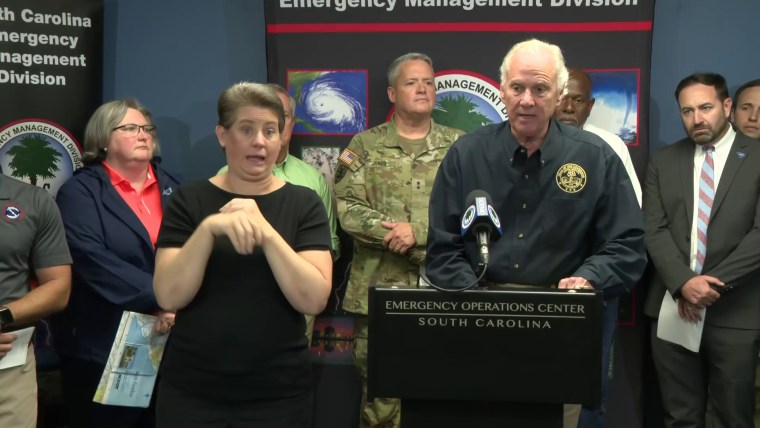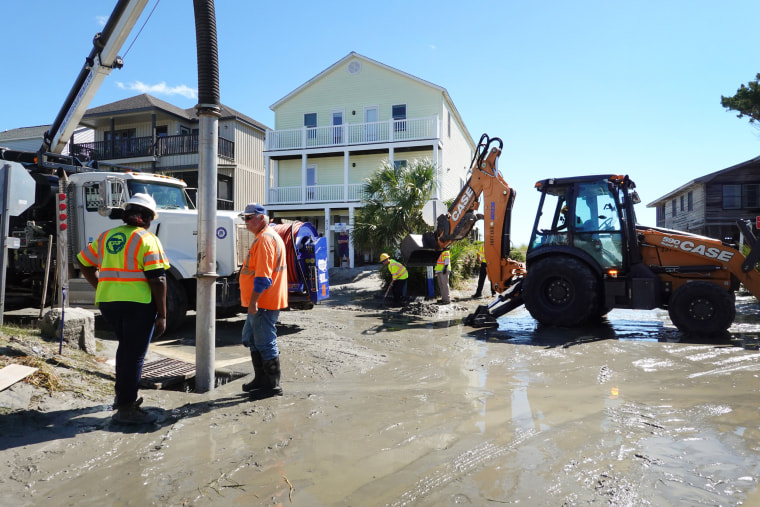CHARLESTON, S.C. — This historic city of graceful mansions and Spanish moss-draped trees dodged the devastation Saturday that Hurricane Ian had visited on Florida. But Charleston was left with yet another reminder of how vulnerable it remains to powerful storms.
The damage to Charleston, a city below sea level with a long history of flooding, appeared minimal the day after Ian barreled into South Carolina as a Category 1 storm.
“People need to realize that Charleston really was largely spared by just 20 or 25 miles,” said state Sen. George "Chip" Campsen, a Republican who represents the area and currently lives on Isle of Palms, a small barrier island just outside Charleston.
Branches and leaves littered the ground, a few trees were down and walls of sandbags were still standing watch by some store entryways.
But the skies were blue and tourists, who had been trapped in their hotels, emerged to find a city mostly unscathed, although here and there some of the iconic Spanish moss had been sloughed-off the trees onto the street.

“It’s our first hurricane, so it was kind of crazy and scary at first,” said Connie Justice, 38, of Philadelphia, as she and her husband were shopping on King Street in downtown Charleston. “I’ve never seen anything like it, but it was not even as bad as half the videos, like the flooding and stuff, coming out of Florida.”
Campsen, who spent Saturday removing storm shutters and getting his boat business back online, said they were all very lucky.
“If you look at what happened up in Pawleys Island and Georgetown, it really was the benefit of being on the west side of the eyewall when it made landfall, which pretty much went right over my house,” he said.
Ian had been forecast to make a direct hit on Charleston. But in the final hours it unexpectedly moved farther up the coastline. That spared the city, which has in recent years taken steps to become less prone to flooding.
City and state leaders have collaborated with the federal government to build a sea wall, which will stretch for 8 miles and cost north of $1.1 billion, to further protect the historic city. They have also set aside about $38 million for a nearly completed drainage tunnel that would push excess water into the nearby Ashley River.

Sally Bullock, the manager of local clothing store Collared Greens in Charleston’s historic district, said these anti-flooding measures are long overdue.
“The biggest problem in downtown Charleston is that we are so prone to flooding,” Bullock said as she showed customers linen shirts and bow ties. “And what they had projected was that it was going to hit at high tide. We’ve had very high tides recently. Once the water comes in here, there’s no place for it to go.”
Still, Bullock said, the city had appeared to do a good job clearing the sewers before Ian arrived and, as a result, the storm itself wasn’t as terrible in Charleston as it might have been.
Bullock said she had some customers from Oklahoma who told her they'd seen worse damage in their state from tornadoes.
“One of them said they weren’t really impressed with this storm,” Bullock said, and I’m like, ‘Honey, that’s a good thing.’”
Justice and her husband, Anthony, had come down to Charleston with a group of friends. She said her husband were golfing when they encountered 50 mph winds on a course closer to the coastline. She said they wound up riding out the worst part of the storm in their hotel lobby before venturing out to the bars, which extended their hours after Ian had gone.
But in the small coastal communities just north of Charleston, Ian was not so forgiving.
Guerry Green, a lifelong resident of Pawleys Island, said the community was largely saved from structural damage that a hurricane’s brutal winds can deliver. But many of their docks were wrecked, the pier was terribly damaged and there was water everywhere.
The storm hit right at high tide, which brought the “highest tide that I have seen since Hugo,” Green said, noting that it hit the coast during the daytime so he could see it coming.
As a result, a huge number of cars were flooded and many homes were swamped with 4 to 6 feet of water, Green said.
After the bridge that connects the island to the mainland was reopened, Green said, “People started going back home at 10 o’clock this morning, homeowners and contractors.
“So I guess, at the end of the day, the cosmetic stuff will be kind of cleaned up," he said. "The longer term stuff — mostly from the water — is going to take some time.”


